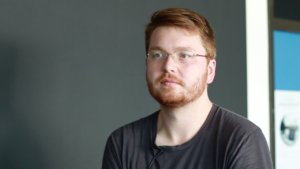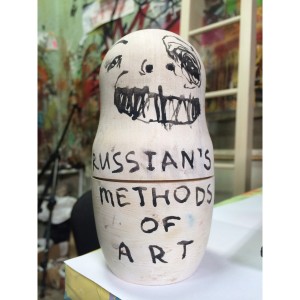My work is shown in, my work is, like, shown in the venues in which – like the venues that are native to like the current contemporary art idiom, basically. But I’d say, possibly, uniquely with a special attention to detail to the spaces that are often very ignored which is the like, the public space of dissemination, the idea that, you know, instead of having to go for example to like a gallery in New York to see my work, that like, actually, the work usually is designed to be received just on my website or through, I don’t know, Instagram or something like that. Like, especially with the Altered Installation Views but also with other work where you, like when you’re looking at it, you’re looking at the thing, there’s no like – there’s nothing even missing, you’re not missing like a walk-through and -around or something, you’re seeing an image which is specifically created to be received on the – like, in the format that you’re receiving it. [unintelligible] if it’s like a website or a book or whatever. I try to not really privilege one method of reception or another. It does become strange, because sometimes it does feel that – how do I put it – it does become strange, because sometimes it feels like, if you just see like one method of seeing, specifically like if you just go and see it in a, like in a gallery space or in a show, or in that kind, it’s like, it’s very much like one discrete experience and I try and tailor that space to be its own, like, self-sustaining experience, if that makes sense, but always in the back of my head, I’m thinking „Oh, but I guess kinda to explain this I need to, like, take out my phone and show, like, images of the other part of what this does and like where this goes.“. But I think that’s probably just my tendency to like either over-explication or – I don’t know, kind of like, intentional willingness to communicate this like other part of it, basically. Because, really, part of the intention is, like distinction stand on its own, basically, and then, if, basically, if the viewers are interested, they go and they see like: „Okay, oh, there is something else to this!“ Like, you maybe try and find images of a show [unintelligible] that you, like, saw in person and then you go on my website and you’re like „This doesn’t look like what I saw, at all.“ like „What’s going on here?“. But, I mean, thankfully, I think like, kind of immediately, usually the viewer gets it, because it’s so, like, the alterations are so obvious, usually, which is I think kind of a, it’s both using the aesthetic trope that exists but also, I think, it’s kind of an strength, that just, like, communicates that „Oh yeah, like, this alteration is clearly part of it because it’s not something, that seems unintentional“, if that makes sense. It doesn’t seem like just an accent, like other color balances offer, something like that, it seems like „This was very, like, these, like aggressive abstracts, alterations were very well fully done to this. “. There isn’t a specific audience in mind. I think, partially, because, you know, what I’m doing is kind of trying to not work exclusively within a single idiom, so in some cases that means that maybe I’ll have a small following in, like, a photography community or something or maybe I’ll have like a small audience in different places or something. And then maybe kind of like a more generalized art audience or something. I don’t know, I think, that’s like interesting to me.

















